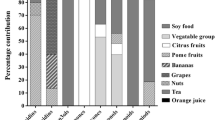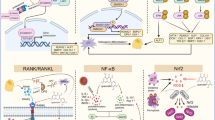Abstract
Osteoporosis and fragility fractures are a growing problem for our aging population with around 1 in 2 women and 1 in 5 men suffering from an osteoporotic fracture during their lifetime. Although there are established factors that can reduce the risk of fracture such as maintaining physical activity, ceasing smoking, and adequate vitamin D status, and intakes of calcium; dietary mechanisms are less well established. The relevance of the flavonoid group of bioactive compounds found in fruits and vegetables has been less investigated. Two human epidemiologic studies in women found positive associations between total dietary flavonoid intake and bone mineral density. Flavonoids may protect against bone loss by upregulating signaling pathways that promote osteoblast function, by reducing the effects of oxidative stress or chronic low-grade inflammation. The limitations of the existing research are explored in the manuscript and it is concluded that further research is needed, in this promising area.
Similar content being viewed by others
References
Papers of particular interest, published recently, have been highlighted as: • Of importance •• Of major importance
van Staa TP, Dennison EM, Leufkens HG, Cooper C. Epidemiology of fractures in England and Wales. Bone. 2001;29(6):517–22.
Sambrook P, Cooper C. Osteoporosis. Lancet. 2006;367(9527):2010–8.
Hardcastle AC, Aucott L, Fraser WD, Reid DM, Macdonald HM. Dietary patterns, bone resorption and bone mineral density in early post-menopausal Scottish women. Eur J Clin Nutr. 2011;65(3):378–85.
McNaughton SA, Wattanapenpaiboon N, Wark JD, Nowson CA. An energy-dense, nutrient-poor dietary pattern is inversely associated with bone health in women. J Nutr. 2011;141(8):1516–23.
Weaver CM, Alekel DL, Ward WE, Ronis MJ. Flavonoid intake and bone health. J Nutr Gerontol Geriat. 2012;31(3):239–53. A comprehensive review of flavonoid intake and bone health.
Wei P, Liu M, Chen Y, Chen DC. Systematic review of soy isoflavone supplements on osteoporosis in women. Asia Pac J Trop Med. 2012;5(3):243–8.
Svedbom A, Hernlund E, Ivergard M, Compston J, Cooper C, Stenmark J, et al. Osteoporosis in the European Union: a compendium of country-specific reports. Arch Osteoporos. 2013;8(1–2):137.
Becker DJ, Kilgore ML, Morrisey MA. The societal burden of osteoporosis. Curr Rheumatol Rep. 2010;12(3):186–91.
The Surgeon General. Bone Health and Osteoporosis: a report of the Surgeon General. Rockville, MD: US Department of Health and Human Services, Office of the Surgeon General. 2004.
United Nations. World Population Prospects: the 2012 Revision, Highlights and Advance Tables. 2013.
Tucker KL, Chen H, Hannan MT, Cupples LA, Wilson PW, Felson D, et al. Bone mineral density and dietary patterns in older adults: the Framingham osteoporosis study. Am J Clin Nutr. 2002;76(1):245–52.
Chen YM, Ho SC, Woo JL. Greater fruit and vegetable intake is associated with increased bone mass among postmenopausal Chinese women. Br J Nutr. 2006;96(4):745–51.
Tucker KL, Hannan MT, Chen H, Cupples LA, Wilson PW, Kiel DP. Potassium, magnesium, and fruit and vegetable intakes are associated with greater bone mineral density in elderly men and women. Am J Clin Nutr. 1999;69(4):727–36.
Zalloua PA, Hsu YH, Terwedow H, Zang T, Wu D, Tang G, et al. Impact of seafood and fruit consumption on bone mineral density. Maturitas. 2006
Prynne CJ, Mishra GD, O'Connell MA, Muniz G, Laskey MA, Yan L, et al. Fruit and vegetable intakes and bone mineral status: a cross sectional study in 5 age and sex cohorts. Am J Clin Nutr. 2006;83(6):1420–8.
Hardcastle A. The influence of fruit and vegetables on postmenopausal women's bone health: Aberdeen University; 2008.
Macdonald HM, Black AJ, Aucott L, Duthie G, Duthie S, Sandison R, et al. Effect of potassium citrate supplementation or increased fruit and vegetable intake on bone metabolism in healthy postmenopausal women: a randomized controlled trial. Am J Clin Nutr. 2008;88(2):465–74.
Macdonald HM, Hardcastle AC, Duthie GG, Duthie SJ, Aucott L, Sandison R, et al. Changes in vitamin biomarkers during a 2-year intervention trial involving increased fruit and vegetable consumption by free-living volunteers. Br J Nutr. 2009;102(10):1477–86 [Epub Jun 23, 2009].
Lin P-H, Ginty F, Appel LJ, Aickin M, Bohannon A, Garnero P, et al. The DASH diet and sodium reduction improve markers of bone turnover and calcium metabolism in adults. J Nutr. 2003;133(10):3130–6.
Muhlbauer RC, Lozano A, Reinli A. Onion and a mixture of vegetables, salads, and herbs affect bone resorption in the rat by a mechanism independent of their base excess. J Bone Miner Res. 2002;17(7):1230–6.
USDA database for the flavonoid content of selected foods [Internet]. 2013. Available at: http://www.ars.usda.gov/nutrientdata/flav.
Amanatidis S, Mackerras D, Simpson JM. Comparison of two frequency questionnaires for quantifying fruit and vegetable intake. Pub Health Nutr. 2001;4(2):233–9.
Haraldsdottir J. Minimizing error in the field: quality control in dietary surveys. Eur J Clin Nutr. 1993;47 Suppl 2:S19–24.
Bingham S, Luben R, Welch A, Low YL, Khaw KT, Wareham N, et al. Associations between dietary methods and biomarkers, and between fruits and vegetables and risk of ischaemic heart disease, in the EPIC Norfolk Cohort Study. Int J Epidemiol. 2008;37(5):978–87.
Hardcastle AC, Aucott L, Reid DM, Macdonald HM. Associations between dietary flavonoid intakes and bone health in a Scottish population. J Bone Miner Res. 2011;26(5):941–7. The first study looking at associations between flavonoids and bone health in humans.
Kyle JA. Flavonoids in Health and Disease: University of Aberdeen; 2006.
Chun OK, Lee SG, Wang Y, Vance T, Song WO. Estimated flavonoid intake of the elderly in the United States and around the world. J Nutr Gerontol Geriatr. 2012;31(3):190–205.
Welch A, MacGregor A, Jennings A, Fairweather-Tait S, Spector T, Cassidy A. Habitual flavonoid intakes are positively associated with bone mineral density in women. J Bone Miner Res. 2012;27(9):1872–8. The second published study on associations between human bone health and flavonoid intakes.
Hertog MG, Kromhout D, Aravanis C, Blackburn H, Buzina R, Fidanza F, et al. Flavonoid intake and long-term risk of coronary heart disease and cancer in the seven countries study. Arch Intern Med. 1995;155(4):381–6.
Kimira M, Arai Y, Shimoi K, Watanabe S. Japanese intake of flavonoids and isoflavonoids from foods. J Epidemiol. 1998;8(3):168–75.
Johnell O, Gullberg B, Kanis JA, Allander E, Elffors L, Dequeker J, et al. Risk factors for hip fracture in European women: the MEDOS Study. Mediterranean Osteoporosis Study. J Bone Miner Res. 1995;10(11):1802–15.
Kanis J, Johnell O, Gullberg B, Allander E, Elffors L, Ranstam J, et al. Risk factors for hip fracture in men from southern Europe: the MEDOS study. Mediterranean Osteoporosis Study. Osteoporos Int. 1999;9(1):45–54.
Hernandez-Avila M, Stampfer MJ, Ravnikar VA, Willett WC, Schiff I, Francis M, et al. Caffeine and other predictors of bone density among pre- and peri-menopausal women. Epidemiology. 1993;4(2):128–34.
Wu CH, Yang YC, Yao WJ, Lu FH, Wu JS, Chang CJ. Epidemiological evidence of increased bone mineral density in habitual tea drinkers. Arch Intern Med. 2002;162(9):1001–6.
Hegarty VM, May HM, Khaw KT. Tea drinking and bone mineral density in older women. Am J Clin Nutr. 2000;71(4):1003–7.
Chen Z, Pettinger MB, Ritenbaugh C, LaCroix AZ, Robbins J, Caan BJ, et al. Habitual tea consumption and risk of osteoporosis: a prospective study in the women's health initiative observational cohort. Am J Epidemiol. 2003;158(8):772–81.
Welch A, Camus J, Dalzell N, Oakes S, Reeve J, Khaw KT. Broadband ultrasound attenuation (BUA) of the heel bone and its correlates in men and women in the EPIC-Norfolk cohort: a cross-sectional population-based study. Osteoporos Int. 2004;15(3):217–25 [Epub Jan 28, 2004].
Khaw KT, Reeve J, Luben R, Bingham S, Welch A, Wareham N, et al. Prediction of total and hip fracture risk in men and women by quantitative ultrasound of the calcaneus: EPIC-Norfolk prospective population study. Lancet. 2004;363(9404):197–202.
Das S, Crockett JC. Osteoporosis - a current view of pharmacological prevention and treatment. Drug Design Dev Ther. 2013;7:435–48.
Nishimura R, Hata K, Matsubara T, Wakabayashi M, Yoneda T. Regulation of bone and cartilage development by network between BMP signalling and transcription factors. J Biochem. 2012;151(3):247–54.
Boyce BF, Xing L. Functions of RANKL/RANK/OPG in bone modeling and remodeling. Arch Biochem Biophys. 2008;473(2):139–46.
Shen CL, Yeh JK, Cao JJ, Chyu MC, Wang JS. Green tea and bone health: evidence from laboratory studies. Pharmacol Res. 2011;64(2):155–61.
Khosla S, Melton III LJ, Riggs BL. The unitary model for estrogen deficiency and the pathogenesis of osteoporosis: is a revision needed? J Bone Miner Res. 2011;26(3):441–51.
Nieves JW. Skeletal effects of nutrients and nutraceuticals, beyond calcium and vitamin D. Osteoporos Int. 2013;24(3):771–86. A comprehensive review of nutrients and bioactive compounds.
Manolagas SC. From estrogen-centric to aging and oxidative stress: a revised perspective of the pathogenesis of osteoporosis. Endocr Rev. 2010;31(3):266–300.
Shen CL, von Bergen V, Chyu MC, Jenkins MR, Mo H, Chen CH, et al. Fruits and dietary phytochemicals in bone protection. Nutr Res. 2012;32(12):897–910.
Peluso I, Raguzzini A, Serafini M. Effect of flavonoids on circulating levels of TNF-alpha and IL-6 in humans: a systematic review and meta-analysis. Molec Nutr Food Res. 2013;57(5):784–801.
Horcajada MN, Offord E. Naturally plant-derived compounds: role in bone anabolism. Curr Molec Pharmacol. 2012;5(2):205–18. A comprehensive review of the role of plant-derived compounds on mechanisms relating to bone health.
Compliance with Ethics Guidelines
Conflict of Interest
A. A. Welch declares no conflicts of interest.
A. C. Hardcastle declares no conflicts of interest.
Human and Animal Rights and Informed Consent
This article does not contain any studies with human or animal subjects performed by any of the authors.
Author information
Authors and Affiliations
Corresponding author
Rights and permissions
About this article
Cite this article
Welch, A.A., Hardcastle, A.C. The Effects of Flavonoids on Bone. Curr Osteoporos Rep 12, 205–210 (2014). https://doi.org/10.1007/s11914-014-0212-5
Published:
Issue Date:
DOI: https://doi.org/10.1007/s11914-014-0212-5




